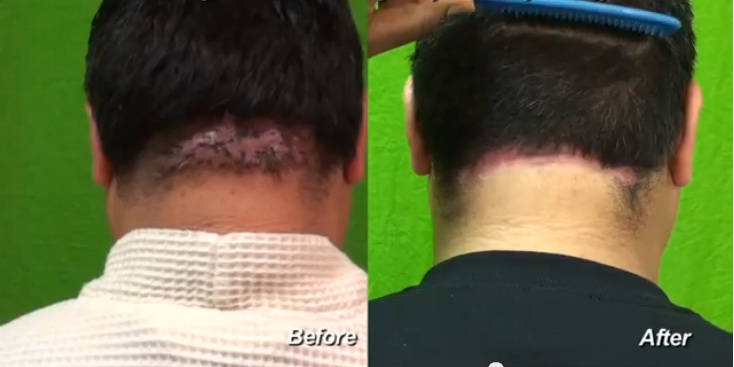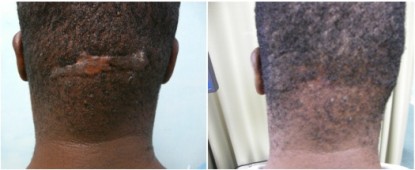
THE ORIGIN AND MANIFESTATION OF Back of Head Razor Bumps
Back of head razor bumps is an idiopathic disorder, meaning research has shown no conclusive evidence of why or how it happens. Studies do definitively show that, in the United States, it is most common among African American males. However, it can occur in varying ethnicities. It is also certain that the disorder begins as small papules and pustules within the hair follicle. At this stage, back of head razor bumps could go unrecognized, or could be perceived as razor bumps on the back of the head. Evidence of possible connection to Razor bumps:
- style=”text-align: left;” itemprop=”description”>Most patients report developing the condition after having shaved their heads with a razor to the skin
- style=”text-align: left;” itemprop=”description”>there is a high incidence of co-existence of the condition inpatients that have beard area razor bumps called pseudofolliculitis barbae
- style=”text-align: left;” itemprop=”description”>The condition is most prevalent or in most instances, the first lesions begin in the skin fold area of the back of the head were the skin rubs against itself hence the first hair stubble that grow after a clean head shave would start stabbing and irritating the opposing skin.
- style=”text-align: left;” itemprop=”description”>Treatments know to ameliorate razor bumps in te beard area such as Laser treatments and some topical creams have been useful in very early forms of back of head razor bumps
Unchecked, back of head razor bumps will continue to grow to large keloid like masses at the affected site. These masses usually grow on the occipital scalp or on the nape of the neck, and are often itchy, painful, or uncomfortable. They are sometimes puss-filled and odorous. With the occurrence of these masses, hair in the affected area no longer grows, or grows in sporadic tufts circling the area. Perhaps the greatest cause for concern with acne keloidalis nuchae is the obvious cosmetic deformity it produces.
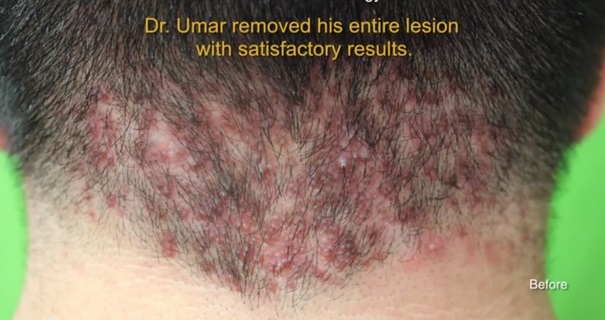
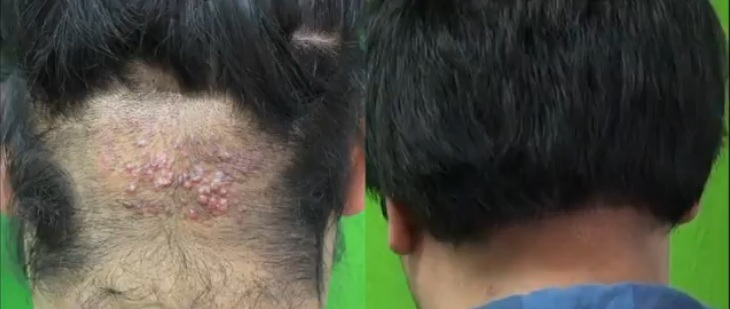
Back of head razor bumps is rarely diagnosed in women, and has a male to female ratio of 20 to 1.
Though the etiology is unknown as previously stated, there are certain sources that have shown a strong cause and effect relationship to the condition. The main cause and effect relationship appears to be ingrown hairs. (However, there are also many cases to the contrary, with no history of the growing hair shaft curving into the skin). Sources affiliated with ingrown hairs include:
- Short haircuts—an observational hospital-based study found this to be the reason in 90% of reported cases
- Frictional trauma—from the use of an electric razor
- Chronic irritation—the repeated chafing of a shirt collar against the head/neck
Other deduced causes of back of head razor bumps include:
- Androgen excess
- Seborrhea
- Cyclosporine use (in Caucasians)
- Autoimmune dysfunction
TREATING back of head razor bumps
Treatment for back of head razor bumps can vary from topical therapies, to intralesional therapy, to surgical excision. The most fitting solution will depend on the stage of the condition, as various treatments have proven successful for different patients and varying severity. Typically, at an earlier stage (when the condition appears as razor bumps or pimples on the back of the head) topical agents may be affective. This includes:
- Antibiotics
- Retinoids
- Immune modulators
- Corticosteroids
Once the disease has advanced to a larger appearance, corticosteroids may be injected as more aggressive treatment. Carbon dioxide laser therapy may also be administered at this stage, or any combination of the aforementioned remedies. At the most advanced stage, whereupon the condition has taken on a tumorous form, these treatments will most likely prove futile. Only surgical excision of the mass will be effective
.
Back of head razor bumps TESTIMONIAL
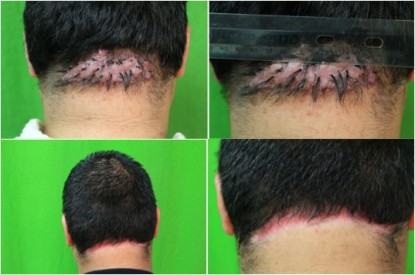
The above patient struggled with back of head razor bumps for six years. It was a time during which he kept his hair long to hide the keloid-like lumps (and was too ashamed, anyway, to visit his usual barber). At one point, he attempted a six-month run of oral medications but saw no improvement. His back of head bumps were itchy and painful. It had an embarrassing odor and was the first thing he thought of when waking up in the morning. When the anxiety became overwhelming, he knew he needed to try a more aggressive solution.
He presented to DermHair Clinic for surgical excision of his back of head mass. Five months post-operation, any trace of the condition is undetectable. Scarring is negligible due to strategic placement of the incision along the posterior hairline.

